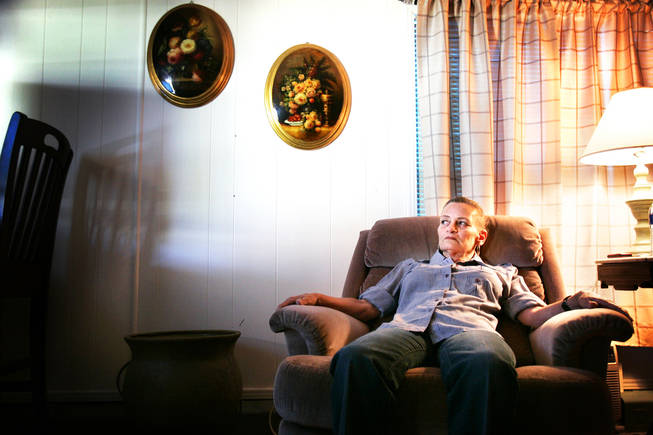
Georganne Mumm sits in her usual spot in her living room. Since her surgery, she is uncomfortable sitting straight up or lying down, so she must sit slightly reclined at all times.
Sunday, Sept. 19, 2010 | 2 a.m.
Do No Harm: Hospital Care in Las Vegas, Part 3
- Patients at risk under the knife
- Routine surgery, harrowing result
- A cry for help
- Doctors avoid discipline
- Colorado transparency unique
- Last drumroll
- How the Sun identified surgical injuries
Share your stories
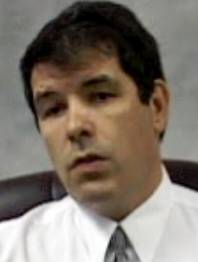
Dr. Victor Grigoriev, top, and Dr. Bill Maranon are seen giving depositions. Grigoriev said he consulted Maranon, who denies he ever received a call.
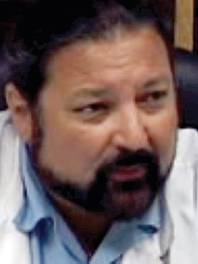
Do No Harm: Amanda Cicatello
When Amanda Cicatello was 15, a surgeon accidentally punctured her aorta with a surgical instrument during an operation to remove her appendix. She nearly bled out and died on the operating table.
Do No Harm: Maria Hoshal
On Nov. 6, 2006, Maria Hoshal's mother, Carol Ann Doyle, had her gall bladder removed at a local hospital. Doyle died eight days later from sepsis.
Dr. Victor Grigoriev had good news for Georganne Mumm's worried family when he emerged from the operating room.
The surgery was a success, Mumm says he told her family. He had removed her cancerous kidney and her outlook was good.
Mumm said her family embraced Grigoriev, a University of Nevada School of Medicine professor and a leader in the Las Vegas medical community.
But that wasn't the complete story of what had happened in a MountainView Hospital operating room on Sept. 4, 2007, records show. Grigoriev mistook part of the 53-year-old's pancreas for a cancerous mass and cut it out, and clamped a vein, strangling her spleen's blood flow, according to medical and legal records filed in Mumm's lawsuit against the surgeon.
Grigoriev said he could not speak about Mumm's case because of ongoing litigation.
Mumm alleges that Grigoriev attempted to cover up his mistakes. Legal and medical records state he did not immediately report his actions to the hospital or write about them in his operative note.
Records also show that at least five doctors knew about Mumm's surgical injuries, but it apparently did not impede Grigoriev's ability to practice at the hospital. He went on to perform hundreds of surgeries at MountainView, records show.
Mumm's injuries are an extreme example of the type of surgical injuries that happen more often than would be expected in most Las Vegas hospitals, according to a Sun analysis of billing records on file with the state. The high rates — more than twice what would be expected in some hospitals — have persisted for a decade, and the systems designed to prevent such injuries have serious shortcomings, the Sun found.
The Sun used methods developed by the federal Agency for Healthcare Research and Quality to identify certain surgical injuries noted in Las Vegas hospital billing records.
The Sun analysis of 2008 and 2009 records revealed 710 accidental punctures or lacerations — more than half during elective procedures. In 38 cases, the patient died in the hospital. (Billing records do not indicate whether the injuries contributed to each patient's death. In nonfatal cases, it's possible injuries were identified and fixed during surgery, with little harm to the patient.)
The findings are the latest in a two-year Sun investigation: "Do No Harm: Hospital Care in Las Vegas," which has involved interviews with more than 160 people — hospital administrators, board members, medical consultants, nurses and more than 50 doctors.
In findings already published, the newspaper reported that in 2008 and 2009, patients suffered preventable injuries, life-threatening infections or other harm 969 times in Las Vegas hospitals. In that time, patients also became infected two types of lethal, drug-resistant "superbugs" in area hospitals 2,010 times.
The Sun's findings lend credence to the poor reputation of medical care in Las Vegas, which is so infamous that governors, mayors and other community leaders have left the state for elective surgeries.
Regarding surgical injuries, doctors and others interviewed highlighted several factors that contribute to problems for Las Vegas patients going under the knife:
• A culture of medical mediocrity persists, in part because there is no center of academic excellence to raise standards.
• Morbidity and mortality conferences — regular meetings in which doctors discuss complicated cases to further their educations — are almost unheard of in Las Vegas hospitals.
• Oversight of physicians by hospitals and colleagues is compromised by financial entanglements. Surgeons generate substantial revenue for hospitals, and doctors benefit from referring patients to one another.
Dr. Bryan Bledsoe, an emergency room physician at University Medical Center and an author and professor at the University of Nevada School of Medicine, said part of the problem is doctors sometimes get so consumed by the pressures of medicine that they lose sight of the human element of their work.
Insurance reimbursements are declining, and physicians have support staff and their lifestyles to maintain, leading some to rush from patient to patient, sometimes without even talking to them, he said.
"The first tenet of medicine is to 'Do No Harm,' and perhaps we've lost some of that along the way," Bledsoe said.
It's not as if a majority of patients are being injured during surgery. Such incidents occur at a rate of 2.52 per 1,000 cases analyzed, the Sun found.
But when they do occur, patients pay the highest price — sometimes with their lives.
Donna Wendt died on March 13, 2009, after an accident at Sunrise Hospital and Medical Center. According to her autopsy report, the 56-year-old's windpipe was torn open when a breathing tube was inserted, causing oxygen to be pumped into her body instead of her lungs.
Fifteen-year-old Amanda Cicatello nearly bled to death during an appendectomy after a surgeon accidentally plunged a surgical device called a trocar through her aorta, according to the doctor's deposition. Three years later, she suffers emotional trauma and is self-conscious about the scar that runs from her breastbone to below her navel.
Mumm spent almost two months in MountainView after Grigoriev operated on her. Enzymes leaking from her severed pancreas burned a tunnel through her intestines and flesh, providing a channel for fecal matter to come through her skin. She is in constant pain and wears a colostomy bag to collect feces.
"I don't go too many places because it smells and it's very embarrassing," Mumm said. "I have a lot of depression."
COMPARING LOCAL, NATIONAL DATA
Hospitals in Las Vegas have a history of higher-than-expected surgical injuries, records show.
The Agency for Healthcare Research and Quality uses hospital billing records to identify surgical injuries — it calls them "accidental punctures or lacerations." Its experts use the injuries as one of many measures to evaluate patient safety in hospitals. The agency's software adjusts for risk — including factors such as age and gender — so each hospital's risk-adjusted rate of surgical injuries can be compared with national norms.
The Sun used agency methods to analyze every hospital inpatient billing record on file with the state from 1999 to 2009, almost 3 million in all.
In 2009, the rates of surgical injuries that were statistically significant — meaning they weren't likely to have occurred by chance — ranged from 34 percent higher than expected at Spring Valley Hospital Medical Center to 174 percent higher than expected at North Vista Hospital and St. Rose Dominican Hospitals — San Martin Campus.
Hospital records on file with the state show that in 2009 Spring Valley had 33 accidental punctures or lacerations, and North Vista and St. Rose — San Martin had 24 and 41, respectively.
Sunrise Health System's 2008 and 2009 data were flawed, a state official said, making its results incomplete. State law requires hospitals to file accurate records, and the three Sunrise hospitals are correcting the data, a state official told the Sun.
Las Vegas hospitals said in written statements that they closely track surgical injuries and monitor surgeons to ensure they provide quality care. Doctors who have problems are supervised and may have their privileges suspended or revoked — although the Sun found this is extremely rare.
The St. Rose Dominican Hospitals were the only facilities to talk to the Sun by its deadline. Dr. Steve Jones, chief medical officer for the three St. Rose hospitals, said they track surgical injuries and rates and compare them with a regional rate produced by the Agency for Healthcare Research and Quality. By that measure the St. Rose hospitals compare favorably, he said.
(Unlike the Sun's analysis, the St. Rose method does not allow for risk-adjusted comparisons. It is also not the standard used by state regulators and the Nevada Hospital Association, the industry's trade group.)
St. Rose also tracks individual cases to see if there are errors in the surgical process that resulted in the accident, Jones said. Many of the injuries fall into the realm of recognized complications, so it's important to identify if a physician is operating outside standard practices, he said.
'WORKING ON THE CAR WITH THE ENGINE GOING'
Doctors refer to all but the most extreme surgical injuries as "misadventures" or "recognized complications" that may fall within an acceptable rate based on medical literature, said Dr. Jim Christensen, an allergist who oversees Spring Valley Hospital's quality of care. He said that's different from malpractice, in which a physician's failure to follow proper standards results in patient harm.
Surgery is "like working on the car with the engine going," Christensen said. "Sometimes something slips, but they recognize the injury right away and repair it. As long as that doesn't go beyond the published error rate, I'm fine."
The Sun contacted two dozen surgeons whose names were listed on the billing records but whose role in the complication was unclear. Most did not want to speak with the Sun.
Only Dr. Elizabeth Hamilton agreed to examine every surgical injury case in which she was named as the operating physician. She said in a written statement that the codes do not necessarily reflect an injury that occurred during surgery. It may have occurred before, and her job would have been to repair the damage, she said.
Also, because tissue surrounding organs is delicate, it is "not uncommon" for unintended minor injuries to occur, she said. "In almost all cases this injury is superficial, easily remedied and not detrimental to the health of the patient."
Seeking an expert on best surgical practices, the Sun was referred by the American College of Surgeons to Dr. John Clarke, professor of surgery at Drexel University in Philadelphia and the clinical director of the Pennsylvania Patient Safety Reporting System.
Clarke said in a written statement that most, but certainly not all, incidents that appear on billing records as accidental punctures or lacerations are technical errors. "The important issue is whether they are errors that harmed the patients or errors with a successful recovery and no harm," Clarke said.
Chip Wallace, administrator of a Las Vegas surgical group, said that if the billing data show problems, then from a moral perspective, they need to be corrected.
"There are surgeons who care and who want to do something about it," he said.
'THE STANDARDS ARE SO LOW,' A PHYSICIAN SAYS
Any effort to raise surgical care standards in Las Vegas will run headlong into a culture of mediocrity, hospital insiders told the Sun.
A physician who has sat on multiple hospital committees overseeing colleagues has compared his peers to a group of supposedly world-class sprinters who are satisfied running the 100-yard dash in 25 seconds when they should be doing it in under 10 seconds.
"The standards are so low they don't even recognize a problem that's staring them in the face," said the doctor, who asked not to be identified because he feared retribution from colleagues.
The absence of an academic center of excellence, such as Johns Hopkins University or Mayo Clinic, contributes to the relaxed standards, the physician said. Such centers bring the latest techniques and best performance standards, forcing all facilities in the community to match their quality or lose business. They also train physicians who go on to work in the community, staffing other hospitals with doctors accustomed to the high standards.
Dr. John Ruckdeschel, director and CEO of Nevada Cancer Institute, said in addition to the region lacking a strong academic center, it suffers because a high proportion of private hospitals — mostly for-profit — rely on doctors who are independent contractors.
These independent physicians obtain privileges to practice at a hospital and generate business for themselves through referrals from other doctors. It's a volume business fed by a physician's contacts in the medical community.
Doctors working in private hospitals are self-policing through confidential oversight committees formed to credential and discipline physicians. But these committees are hampered by the members' financial entanglements, Ruckdeschel said. A doctor is unlikely to criticize a colleague's performance if it means possibly losing referrals.
"There's a conflict of interest," Ruckdeschel said. "The people who are doing the work are overseeing the work, and there's no way to get a look at that from the outside."
Wallace said a few doctors are committing most of the surgical injuries — which would be consistent with findings of national studies. An analysis by the advocacy organization Public Citizen found 6 percent of doctors nationwide accounted for 82 percent of malpractice payments from 1990 to 2005.
The challenge is helping the few surgeons who are having problems improve, Wallace said.
Those troubled physicians, however, introduce lawyers into the peer-review process, Wallace and several doctors said, which makes it difficult to correct or eliminate problems.
In contrast, at academic medical centers, doctors regularly review one another's cases during morbidity and mortality conferences. The objective of these critiques is to learn together and push one another to improve. Clarke said surgical injuries should be discussed in hospitals at "regularly scheduled" conferences.
UMC, the primary partner of the University of Nevada School of Medicine, one of the smallest medical schools in the country, holds morbidity and mortality conferences. But they are unheard of at most private hospitals in Las Vegas, doctors told the Sun. One, a former chief of staff at two local hospitals, said he had never heard of a morbidity and mortality conference at any Las Vegas hospital outside UMC. Jones said they do not occur at the St. Rose hospitals because they are something that takes place at academic institutions.
"It's a nominal process here," Ruckdeschel said.
Not everyone accepts the status quo.
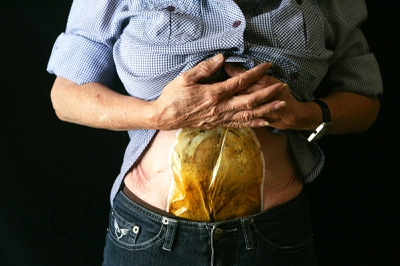
Georganne Mumm holds onto the ostomy bag she wears all the time in her home Wednesday, September 8, 2010. During surgery Sept. 4, 2007 to remove a cancerous kidney, Dr. Victor Grigoriev cut out part of Georganne Mumm's pancreas and clamped a vein, strangling the blood supply to her spleen. Both had to be removed in a follow-up surgery. Georganne Mumm now lives in constant pain, wears an ostomy bag and rarely leaves her home in Bullhead City, Arizona.
Bledsoe, the UMC emergency room physician, said the high rates of surgical injuries in Las Vegas hospitals identified by the Sun may require the medical community to stand down, take a step back and evaluate the entire system.
Doctors need to be honest about surgical injuries and implement best practices that have been adopted elsewhere, he said.
DOCTORS AWARE OF COLLEAGUE'S ACTIONS
Grigoriev is the former chief of urology at the University of Nevada School of Medicine. From 1995 to 2009, he was chief of urology at UMC, where he served on its medical executive committee, monitoring the quality of care and disciplining his peers. For his services, UMC paid him almost $1.1 million a year.
Yet Mumm's case isn't the only instance in which his performance has been criticized, according to his deposition in the Mumm lawsuit and other case records.
He said in his July 12 deposition, available at lasvegassun.com, that his privileges have been suspended 10 to 20 times at MountainView and other hospitals for failing to file operative reports on time.
Operative reports are supposed to be completed within 24 hours of surgery at MountainView, but Grigoriev did not file a report on Mumm's surgery until Dec. 2, 2007, almost three months after the operation. He claimed his original dictation was lost by MountainView.
Nevada requires sentinel events — incidents in which a patient is unexpectedly injured — to be reported to the state within 24 hours. But Grigoriev said he did not report the injury to anyone until after he was sued.
As a urologist, Grigoriev should have called on a general surgeon to repair Mumm's injured pancreas.
Grigoriev said in his deposition that he called a surgeon for advice. He said he reached Dr. Bill Maranon by phone and followed his instructions.
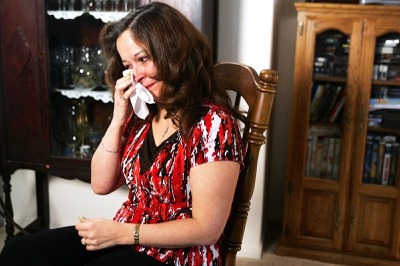
Maria Hoshal recalls her mother Carol Ann Doyle's death inside her home in Las Vegas March 12, 2010. Carol Ann Doyle suffered intense pain in the days after her Nov. 6, 2006 laparoscopic gall bladder removal surgery at St. Rose Dominican Hospitals - Siena Campus. Her family says they took her back to the hospital and the office of her surgeon, Dr. Gregg Ripplinger, but were told not to worry and to take more pain medications. After a week of crippling pain she was rushed to the Spring Valley Hospital emergency room where a scan and emergency surgery revealed that a clamp had been misplaced during the initial surgery, which meant bile was leaking into her abdomen, causing her to become infected. She died Nov. 13, 2006.
In his deposition Maranon denied speaking to Grigoriev during the surgery. "I never received a call," Maranon said, adding that he would have remembered such an unusual incident.
Mumm was rushed into surgery the next day, where Dr. Lee Reese, a general surgeon, cleaned up the damage — removing the rest of her pancreas and her injured spleen, medical records state.
"She is high risk for postoperative problems," Reese wrote in his operative report, noting the initial injury was caused by a physician.
Reese is one of at least five MountainView physicians who knew about Mumm's injuries, medical records show.
Yet Grigoriev was never suspended for the injuries, he said in his deposition.
In 2008 and 2009, since Mumm's surgery, Grigoriev is listed as the operating physician on 257 patient records at MountainView, and on records at six other Las Vegas hospitals, according to the Sun's analysis of billing records. It's unknown whether any of his cases have been reviewed.
MountainView officials did not reply to a request for comment about Grigoriev.
Indeed, Mumm has suffered problems. She's cancer free, but fearful of seeing a doctor or entering a hospital to replace her colostomy bag.
Not that she could afford it. She has lost her job because she is disabled, is uninsured and deep in debt. Although her insurance covered the initial surgery, the complications exceeded her $500,000 policy limits. The lengthy hospital stay left her owing $352,000.
She is paying, literally, for her surgeon's mistakes.

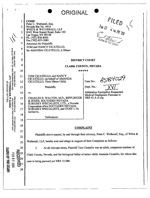

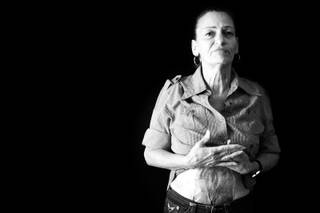
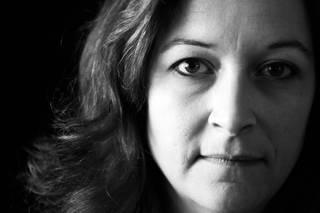


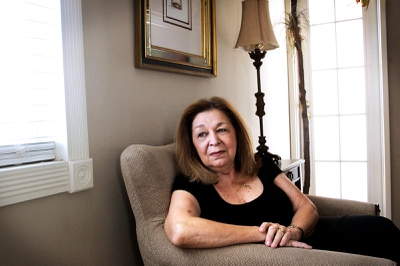

Join the Discussion:
Check this out for a full explanation of our conversion to the LiveFyre commenting system and instructions on how to sign up for an account.
Full comments policy